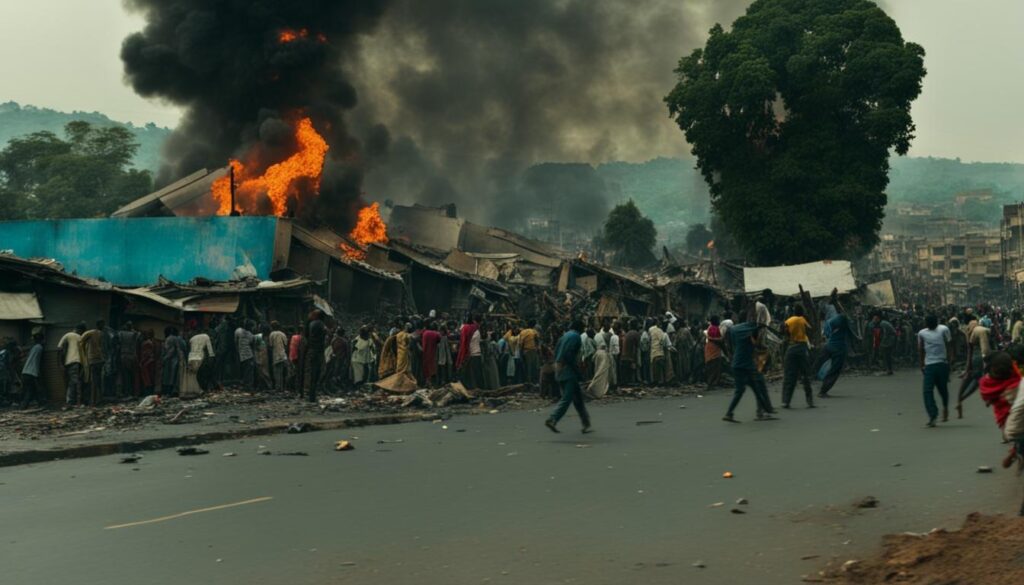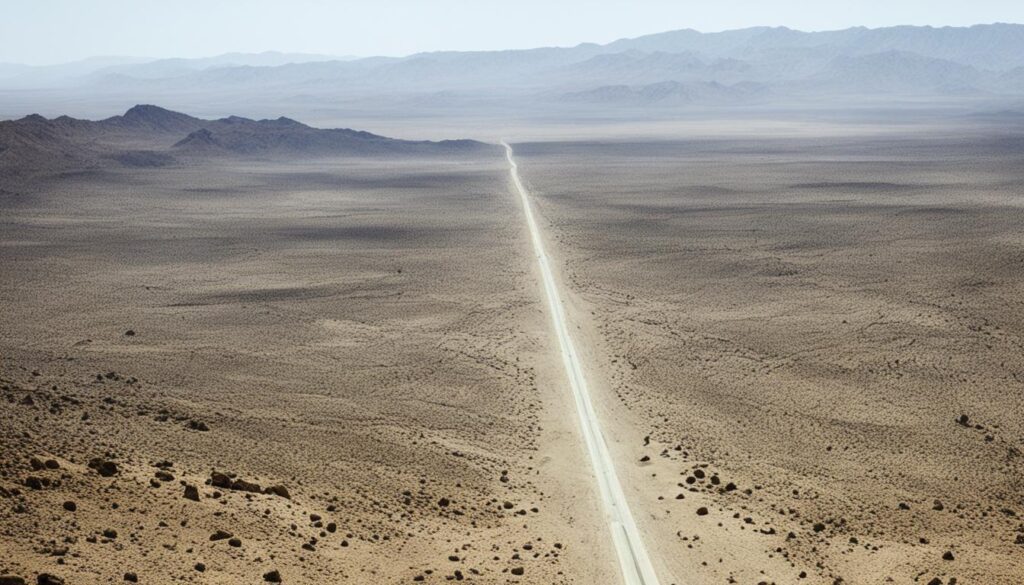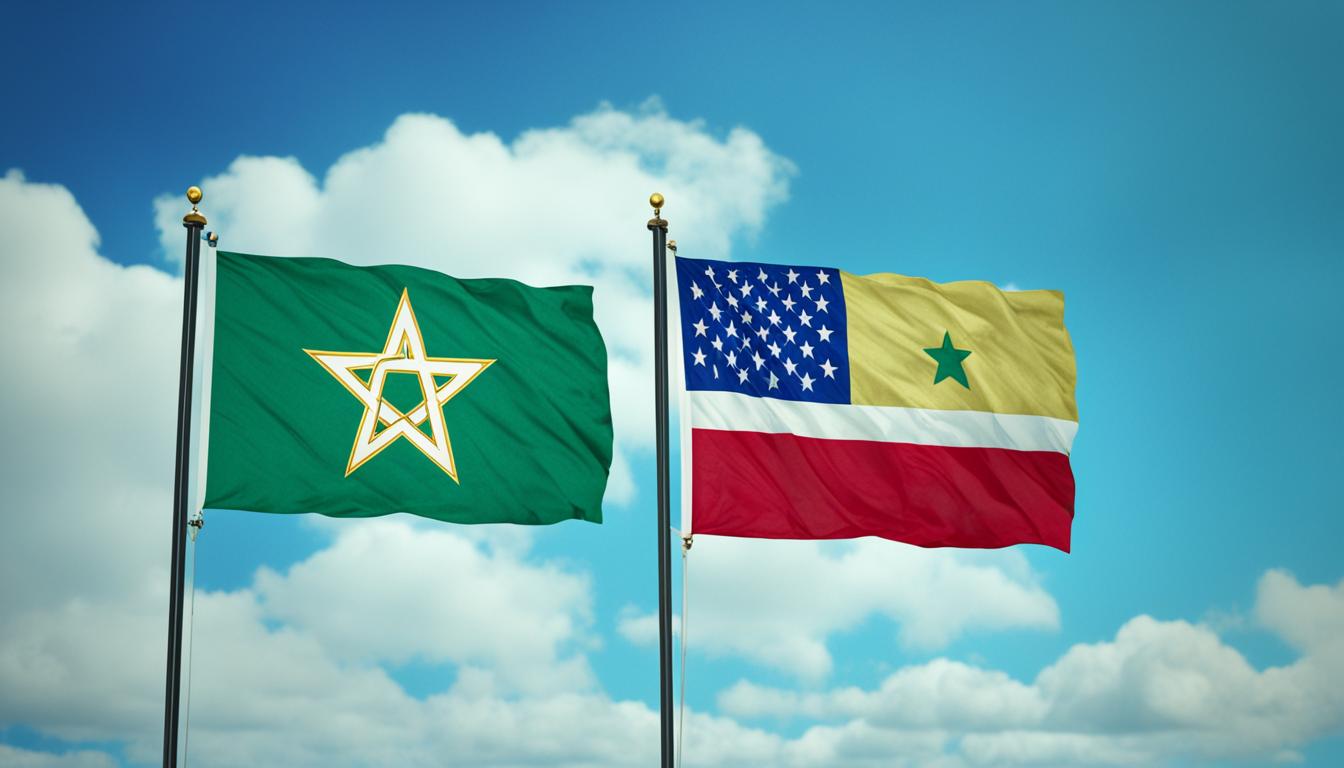Are Ethiopia and Eritrea Still at War?
Did you know that the conflict between Ethiopia and Eritrea has been ongoing for decades, with periods of peace interspersed with bouts of hostilities?
Despite recent efforts to resolve their differences, tensions have resurfaced, and the two nations find themselves on the brink of war once again. The potential consequences of a full-scale conflict between Ethiopia and Eritrea are unsettling, and the international community is closely monitoring the situation.
Key Takeaways:
- The relationship between Ethiopia and Eritrea has been characterized by periods of peace and conflict.
- The dispute centers around Ethiopia’s desire to regain access to the Red Sea, which it lost when Eritrea gained independence in 1991.
- Recent tensions and troop movements have raised concerns about the potential for a full-scale war.
- The international community and regional actors are actively involved in efforts to deescalate the situation.
- A peaceful resolution is crucial to avoiding humanitarian crises and economic impacts on both nations.
Historical Background of Ethiopia and Eritrea Relations
The history of relations between Ethiopia and Eritrea is marked by a complex interplay of events, rooted in their struggle for independence from the oppressive Derg regime in Ethiopia. After Eritrea gained independence in 1993, tensions emerged over the demarcation of the border between the two nations, leading to a protracted dispute.
The Tigray People’s Liberation Front (TPLF) played a significant role in the histories of both Ethiopia and Eritrea. Prime Minister Abiy Ahmed, the current leader of Ethiopia, has accused the TPLF of accepting Eritrea’s independence, which he sees as derailing peace efforts and contributing to the ongoing tensions.
Eritrea’s President, Isaias Afwerki, has ruled the country as a dictator for decades. Afwerki has been known to support proxy warfare, adding to the complexity of the dynamics between the two nations.
Understanding the historical background of Ethiopia and Eritrea is crucial in comprehending the intricate nature of their current relationship, as it sheds light on the various factors that have shaped their interactions and continue to influence their present-day dynamics.
The image represents the historical background of Ethiopia and Eritrea, showcasing their shared history and the complexity of their relationship.
Recent Developments in Ethiopia-Eritrea Relations
In recent years, the relationship between Ethiopia and Eritrea has undergone significant developments and transitions. There have been efforts to establish peace and reconcile the two nations, but these initiatives have faced challenges and setbacks along the way.
One of the key recent developments was the Eritrean-Ethiopian peace deal in 2018. Prime Minister Abiy Ahmed and President Isaias Afwerki declared an end to the state of war between their respective countries. This historic agreement marked a turning point in the long-standing conflict between Ethiopia and Eritrea.
As a result of the peace deal, embassies were reopened, flights between the two nations resumed, and trade relations were facilitated. The international community celebrated this progress, and Abiy Ahmed even received the Nobel Peace Prize in 2019 for his efforts to resolve the border dispute with Eritrea.
“Peace does not arise from the actions of one party alone. When Prime Minister Abiy reached his hand to me, I grabbed it,” said President Isaias Afwerki during their meeting.
However, despite these positive developments, the peace deal faced challenges and tensions resurfaced between Ethiopia and Eritrea. Several unresolved issues persisted, leading to renewed concerns and the potential for conflict.
The peace movements in both Ethiopia and Eritrea continue to advocate for lasting peace and improved diplomatic relations. While recent developments have created hope, the future of Ethiopia-Eritrea relations remains uncertain.
Key Recent Developments in Ethiopia-Eritrea Relations:
- Eritrean Ethiopian Peace Deal
- Abiy Ahmed Receives Nobel Peace Prize
- Reopening of Embassies
- Resumption of Flights
- Facilitated Trade
We will continue to monitor the situation and provide updates on the evolving dynamics between Ethiopia and Eritrea.
| Recent Developments | Status |
|---|---|
| Eritrean-Ethiopian peace deal | Challenged, unresolved issues |
| Reopening of embassies | Progress, improved diplomatic relations |
| Resumption of flights | Positive, increased mobility |
| Facilitated trade | Positive, economic cooperation |
Current Tensions and Potential for Conflict
Recent reports suggest that Ethiopia is amassing troops near the Eritrean border, raising concerns about a potential war. Eritrean military sources indicate that the country is preparing for conflict, as Ethiopia focuses its military actions on areas near the Eritrean border. The current situation is precarious, and any minor incident or miscalculation could escalate into a full-scale war between the two countries. The troop movements and heightened tensions have alarmed neighboring countries and international actors.
The potential for a conflict escalation between Ethiopia and Eritrea poses significant risks not only for the two nations but also for the stability of the entire region. The consequences of such a war would be devastating, impacting the lives of countless civilians and exacerbating existing humanitarian crises. It is crucial for regional and international actors to step up their diplomatic efforts and engage in meaningful dialogue to deescalate tensions and find a peaceful resolution to the current conflict.
Regional and International Efforts to Deescalate

The resolution of tensions between Ethiopia and Eritrea requires the collective efforts of regional and international actors. Recognizing the importance of peace in the region, various countries and organizations have taken steps to deescalate the situation and promote a peaceful resolution.
Regional Efforts Ethiopia Eritrea Peace
Regional actors, such as the African Union (AU), have been actively involved in peacebuilding efforts between Ethiopia and Eritrea. The AU has called for restraint and emphasized the importance of respecting the independence and territorial integrity of all countries in the region. Through diplomatic channels and regional initiatives, the AU seeks to facilitate dialogue and promote lasting peace in the Horn of Africa.
International Mediation Ethiopia Eritrea
The international community has also played a significant role in mediating the Ethiopia-Eritrea conflict. International organizations, including the United Nations (UN), have encouraged dialogue and supported diplomatic efforts to deescalate tensions. Through diplomatic missions and peacebuilding initiatives, these organizations aim to facilitate effective communication and foster a conducive environment for conflict resolution.
United States Role Ethiopia Eritrea
The United States has expressed its concern regarding the escalating tensions and potential for conflict between Ethiopia and Eritrea. As a key regional and global player, the United States has called for restraint and urged both parties to engage in peaceful dialogue. Through diplomatic channels and engagement with regional actors, the United States seeks to contribute to the deescalation of tensions and the promotion of a peaceful resolution.
African Union Involvement Ethiopia Eritrea
The African Union has been actively involved in efforts to deescalate tensions between Ethiopia and Eritrea. Recognizing the potential regional implications of a conflict, the AU has emphasized the need for peaceful resolution and encouraged both countries to engage in constructive dialogue. Through mediation and diplomatic initiatives, the African Union aims to facilitate a mutually acceptable solution that ensures long-term peace and stability in the region.
| Regional Actors | Actions |
|---|---|
| African Union (AU) | Calling for restraint and respecting territorial integrity |
| United States | Urging dialogue and peaceful resolution |
Efforts by regional and international actors highlight the collective commitment to deescalating tensions between Ethiopia and Eritrea. By working together, these actors aim to create an environment conducive to peaceful dialogue and realizing a sustainable solution to the conflict.
Consequences of a Potential War
A full-scale war between Ethiopia and Eritrea would have severe consequences. Previous wars and conflicts between the two countries resulted in significant loss of life and displacement of people. The Tigray conflict, in particular, has caused a humanitarian crisis, with millions of people in need of assistance.
“The consequences of conflict are dire, with innocent civilians paying the highest price. We must do everything in our power to prevent war and protect the lives of those affected.” – International Humanitarian Organization
Furthermore, a war would have a devastating economic impact on both countries. Infrastructure, agricultural production, and trade would suffer, leading to job losses and increased poverty. The disruption of essential services, such as healthcare and education, would further exacerbate the humanitarian crisis.
To illustrate the potential economic impact, let’s compare the key sectors affected by the conflict:
| Consequences | Ethiopia | Eritrea |
|---|---|---|
| Loss of human life | High casualty rate due to conflict | Significant loss of life among military personnel |
| Displacement and refugees | Thousands displaced, seeking refuge within the country | Displaced population, seeking refuge in neighboring countries |
| Humanitarian crisis | Millions in need of emergency assistance | Population heavily reliant on humanitarian aid |
| Economic impact | Decline in GDP, job losses, reduced investment | Disruption of trade, loss of foreign direct investment |
| Post-conflict recovery | Challenges in rebuilding infrastructure and social services | Dependence on international aid for reconstruction |
A post-conflict recovery process would require substantial financial resources and long-term investment for reconstruction efforts. Collaborative efforts from the international community, regional actors, and humanitarian organizations would be crucial for supporting the recovery and rebuilding of Ethiopia and Eritrea.
Why is a post-conflict recovery crucial?
A comprehensive recovery process is essential for addressing the damage caused by the war and promoting sustainable peace. A successful recovery would not only restore infrastructure and basic services but also focus on reconciliation, social cohesion, and the reintegration of displaced populations.
Post-conflict recovery efforts should prioritize:
- Socio-economic development
- Healthcare and education system strengthening
- Job creation and sustainable livelihoods
- Psychosocial support for affected communities
- Rebuilding trust and promoting reconciliation
The image above represents the potential consequences of a war between Ethiopia and Eritrea, emphasizing the impact on civilians, the economy, and the urgent need for post-conflict recovery.
Internal Challenges in Ethiopia and Eritrea

Aside from the tensions between Ethiopia and Eritrea, both countries also face internal challenges that further complicate the potential for peace in the region.
In Ethiopia, internal conflicts have erupted, resulting in significant violence and displacement. The Amhara and Oromia regions have been particularly affected, with ongoing fighting and clashes between different groups.
Ethnic tensions also pose a challenge in Ethiopia. The diversity of ethnic groups within the country has led to complex dynamics and occasional unrest as different communities vie for power and resources.
In Eritrea, there are concerns about human rights abuses and the authoritarian rule of President Isaias Afwerki. The government has been accused of suppressing political dissent, restricting freedom of speech, and violating the rights of its citizens.
Addressing these internal challenges is crucial for promoting stability and creating a conducive environment for dialogue and peace between Ethiopia and Eritrea.
The Ongoing Conflicts in Ethiopia
The fighting in the Amhara and Oromia regions has resulted in widespread violence and displacement. The conflict between different ethnic groups has deep historical roots, and unresolved grievances continue to fuel tensions.
“The ethnic clashes in Ethiopia have created a volatile situation, with communities pitted against each other and the government struggling to maintain control.” – Local Expert
Ethnic Tensions and Political Instability
Ethiopia’s ethnic diversity presents both opportunities and challenges. The struggle for political power and resources among different ethnic groups has at times escalated into violence and instability.
“Ethnic tensions in Ethiopia highlight the need for a more inclusive and equitable political system that addresses the aspirations and grievances of all ethnic groups.” – Political Analyst
Human Rights Concerns in Eritrea
Eritrea is often criticized for its human rights record. President Isaias Afwerki’s authoritarian rule has been characterized by limited political freedoms, suppression of dissent, and allegations of torture and arbitrary detention.
“The human rights situation in Eritrea is deeply concerning, with severe restrictions on freedom of expression and association. Addressing these issues is vital for the well-being of the Eritrean people.” – Human Rights Activist
| Challenges in Ethiopia | Challenges in Eritrea |
|---|---|
| Internal conflicts | Authoritarian rule |
| Ethnic tensions | Human rights abuses |
| Political instability |
International Efforts to Promote Dialogue and Peace
In the quest for international peacebuilding between Ethiopia and Eritrea, several organizations, including the United Nations (UN), have been actively involved. Diplomatic efforts, mediation, and conflict resolution initiatives are being undertaken to find a sustainable solution to the tensions that prevail between the two countries.
The United Nations, in particular, has played a significant role in facilitating negotiations and supporting peacebuilding efforts in the region. Through various channels, the organization has been engaged in diplomatic endeavors, advocating for dialogue, and endeavoring to foster a peaceful resolution. The involvement of the United Nations highlights the global commitment to promoting peace and stability.
“Peace is not the absence of conflict, but the ability to cope with it.” – United Nations
With the understanding that conflicts can have far-reaching consequences beyond the nations involved, international actors are working together to address the tensions between Ethiopia and Eritrea. By promoting dialogue and encouraging peaceful negotiation, these efforts aim to create an environment conducive to stability, cooperation, and development.
Through sustained international engagement, there is hope that the diplomatic endeavors and conflict resolution initiatives can pave the way for a lasting peace between Ethiopia and Eritrea. By fostering understanding, trust, and mutual respect, the international community strives to create a solid foundation for a peaceful future in the region.
United Nations Involvement
The United Nations has a long history of involvement in conflict resolution and peacekeeping efforts around the world. In the case of Ethiopia and Eritrea, the organization has been actively engaged in promoting dialogue, facilitating negotiations, and providing support to both countries in their pursuit of peace.
Through its specialized agencies and programs, the United Nations has been instrumental in addressing various aspects of the conflict between Ethiopia and Eritrea. From humanitarian assistance to peacebuilding initiatives, the organization’s multifaceted approach aims to contribute to a sustainable resolution of the tensions in the region.
Diplomatic Efforts
Diplomatic efforts play a crucial role in resolving conflicts and establishing lasting peace. In the case of Ethiopia and Eritrea, diplomatic channels have been utilized to foster dialogue, bridge differences, and find common ground.
Through diplomatic engagements, countries and international organizations work together to promote understanding, negotiate agreements, and address the underlying causes of the conflict. By encouraging open and constructive dialogue, diplomatic efforts create an atmosphere that fosters reconciliation and paves the way for peaceful coexistence.
Conflict Resolution Initiatives
Conflict resolution initiatives focus on finding sustainable solutions to conflicts and promoting peaceful outcomes. In the case of Ethiopia and Eritrea, numerous conflict resolution initiatives have been undertaken to address the tensions and work towards a lasting resolution.
These initiatives involve various stakeholders, including international organizations, regional actors, and influential countries, who collaborate to facilitate negotiations, mediate disputes, and encourage cooperation between the two nations. By providing a structured framework for resolving conflicts, these initiatives contribute to the overall peacebuilding process.
| Initiative | Description |
|---|---|
| United Nations Peacekeeping Missions | The United Nations has deployed peacekeeping missions to the region to monitor ceasefires, support local authorities, and aid in the implementation of peace agreements. |
| African Union Mediation | The African Union has been actively mediating between Ethiopia and Eritrea, facilitating dialogue and negotiations to find common ground. |
| Regional Economic Communities | Regional economic communities, such as the Intergovernmental Authority on Development (IGAD), have been involved in conflict resolution efforts, helping to create platforms for dialogue and negotiation. |
The Algiers Agreement and Border Demarcation

The Algiers Agreement, signed in 2000, aimed to bring an end to the Eritrean-Ethiopian War and establish a framework for peace between the two countries. This agreement was a significant milestone in the efforts to resolve the long-standing conflict and restore stability in the region.
Under the terms of the Algiers Agreement, a boundary commission was established to demarcate the border between Ethiopia and Eritrea. The commission was tasked with determining the exact location of the border based on historical records, treaties, and international law.
The demarcation process, however, proved to be challenging and contentious. Disputes over the interpretation of the border demarcation led to delays and disagreements between Ethiopia and Eritrea, hindering progress towards a final resolution.
The Permanent Court of Arbitration, a recognized judicial body, later ruled on the disputed territories between Ethiopia and Eritrea. The court’s ruling awarded some areas to Eritrea, further cementing the boundary between the two nations.
Despite the rulings and the Algiers Agreement, the border demarcation process remains incomplete, contributing to ongoing tensions between Ethiopia and Eritrea. The unresolved disputes over certain territories continue to be a source of diplomatic, political, and military challenges for both countries.
The Algiers Agreement and the subsequent rulings by the Permanent Court of Arbitration represent important steps towards peace and stability in the region. However, the full implementation of the border demarcation is necessary for a lasting resolution of the border dispute between Ethiopia and Eritrea, which would contribute to a more peaceful and prosperous future for both nations.
The Role of External Actors and Proxy Wars
The conflict between Ethiopia and Eritrea is not isolated but significantly influenced by external actors and regional power struggles. These external actors have played a vital role in exacerbating the tensions between the two countries, escalating the situation to proxy wars and destabilizing influences. Understanding the involvement of these external actors is crucial in comprehending the complexities of the conflict and the potential for further destabilization in Ethiopia and Eritrea.
The Proxy Wars in Ethiopia and Eritrea
Various countries with their own geopolitical interests have supported different sides in the conflict, effectively turning Ethiopian and Eritrean soil into battlegrounds for proxy wars. By providing military assistance, training, and resources to their respective sides, these external actors have perpetuated the cycle of violence and hindered efforts towards peace.
The proxy wars not only prolong the conflict but also intensify its impact on the local population, leading to increased human suffering and displacement. This perpetuation of violence through proxy actors further complicates the prospects for a peaceful resolution between Ethiopia and Eritrea.
Regional Power Struggles and Destabilizing Influences
Regional power struggles also contribute to the destabilization of Ethiopia and Eritrea. Neighboring countries often have competing interests in the region, leading to support for actors aligned with their agendas. This engagement can exacerbate existing tensions and create additional conflicts that harm the prospects for peace.
These destabilizing influences from neighboring countries heighten the risk of escalation and widen the scope of the conflict beyond the borders of Ethiopia and Eritrea. The potential for regional spillover poses a serious threat to the stability of the Horn of Africa and the larger geopolitical landscape.
Understanding the involvement of external actors and the role of proxy wars is essential in assessing the dynamics of the conflict between Ethiopia and Eritrea. It highlights the need for regional and international efforts to address these influences and focus on sustainable solutions that promote lasting peace and stability in the region.
Peacebuilding and Sustainable Solutions
Achieving sustainable peace between Ethiopia and Eritrea requires comprehensive peacebuilding efforts and conflict transformation. It goes beyond resolving the immediate tensions and encompasses addressing the root causes of the conflict. To ensure long-term stability in the Horn of Africa, it is crucial to promote inclusive dialogue, reconciliation, and cooperation between the two nations.
Regional and international actors must play a vital role in supporting sustainable solutions that address historical grievances and foster an environment conducive to peace. By investing in peacebuilding efforts, the international community can contribute to the transformation of the Ethiopian-Eritrean conflict and promote lasting peace in the region.
Promoting Inclusive Dialogue
One of the key aspects of peacebuilding is the promotion of inclusive dialogue between Ethiopia and Eritrea. This involves creating spaces where representatives from both countries can come together to discuss their grievances, concerns, and aspirations. Inclusive dialogue allows for the expression of diverse perspectives and the identification of common ground.
Through dialogue, stakeholders can work towards finding mutually beneficial solutions that address the underlying issues contributing to the conflict. This approach promotes understanding, empathy, and shared responsibility, which are essential for building sustainable peace.
Reconciliation and Healing
Another important element of peacebuilding is the promotion of reconciliation and healing. Reconciliation involves acknowledging and addressing past wrongs, promoting forgiveness, and building trust between communities and individuals affected by the conflict.
Efforts towards reconciliation and healing can take various forms, such as truth and reconciliation commissions, community dialogues, and cultural exchange programs. By providing opportunities for individuals and communities to share their experiences and reconcile their differences, lasting peace can be established.
Cooperation and Collaboration
Cooperation and collaboration between Ethiopia and Eritrea are crucial for sustainable peace. This involves building mutually beneficial relationships in various sectors, such as trade, infrastructure development, and cultural exchanges. Through cooperation, both countries can work towards shared goals and build trust over time.
Additionally, collaboration in addressing regional challenges, such as climate change, migration, and security issues, can foster closer ties and promote a sense of shared responsibility. By emphasizing common interests and working towards collective solutions, Ethiopia and Eritrea can pave the way for long-term stability in the Horn of Africa.
“Sustainable peace is not achieved through quick fixes or temporary agreements. It requires a sustained commitment to peacebuilding, conflict transformation, and addressing the root causes of the conflict.” – Peacebuilding Expert
By investing in comprehensive peacebuilding efforts, the international community can contribute to the attainment of sustainable peace in Ethiopia and Eritrea. It is essential to support initiatives that promote inclusive dialogue, reconciliation, and cooperation between the two nations. Only through these collective efforts can we transform the conflict and build a future of peace and prosperity in the Horn of Africa.
Comparative Analysis of Peacebuilding Efforts
| Peacebuilding Effort | Effectiveness | Key Challenges |
|---|---|---|
| Regional Mediation | Has shown some progress in facilitating dialogue and fostering cooperation | Complexities of the conflict and diverging interests of regional actors |
| Track II Diplomacy | Provides an informal platform for dialogue and trust-building | Limited influence on formal peace processes and decision-making |
| Civil Society Initiatives | Fosters people-to-people engagement and grassroots peacebuilding | Resource constraints and limited access to conflict-affected communities |
| International Aid and Development Programs | Supports post-conflict recovery and socioeconomic development | Ensuring equitable distribution of resources and sustainability of interventions |
Conclusion
The current situation between Ethiopia and Eritrea is of significant concern, with the risk of escalating tensions and a potential return to full-scale war. However, there remains hope for a peaceful resolution as efforts to deescalate, mediate, and promote dialogue continue. It is crucial for the international community, regional actors, and the people of both Ethiopia and Eritrea to come together and find sustainable solutions.
Despite the complexities and historical grievances, a peaceful future is possible. By working collaboratively, we can create an environment that fosters understanding, reconciliation, and cooperation. This includes addressing the root causes of the conflict, promoting inclusive dialogue, and supporting peacebuilding efforts in the region.
Looking ahead, the future prospects for Ethiopia and Eritrea depend on the commitment of all stakeholders to pursue peace. By prioritizing diplomacy, respecting international borders, and upholding the principles of sovereignty and territorial integrity, we can build a stable and prosperous future for the region. The path to peace may be challenging, but it is a journey worth embarking upon for the well-being and security of both Ethiopia and Eritrea.




